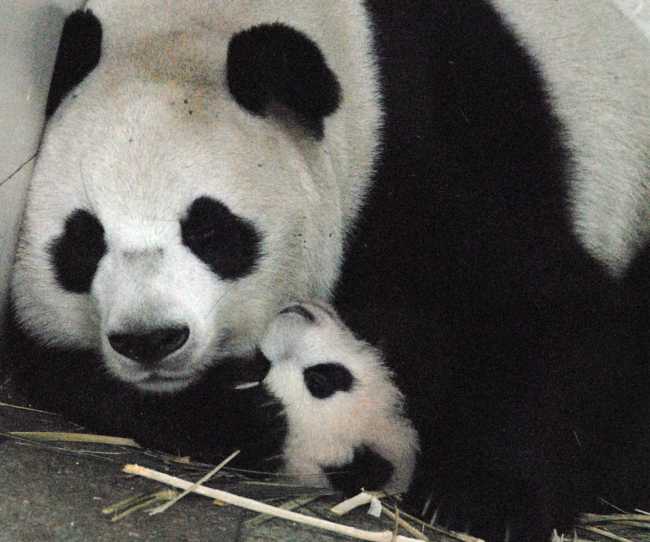Since the pandas aren’t going into estrous just yet and I have a bit of down time on my hands I thought maybe you guys would enjoy learning about a different panda every week I’m here. This week, meet Mei Qing. She’s a little quirky and a little sassy. You can’t tell from these pictures but she’s one of the more active female pandas on the base. Unlike most of the pandas, and most of the Chinese, she doesn’t usually take an afternoon nap from 12:30-2:00pm. Instead she likes to take pretty leisurely walks around her enclosure and munch on bamboo by her door (both favorite past times of pandas).
However, I personally love when she sleeps because she prefers the funniest positions. Like the picture above where she’s lying on her rocks with her right foot in between her forepaws. Or the one below where she’s curled into a little ball in the corner (I’d just woken her up by walking towards her – Sorry Mei Qing!).
Mei Qing was born in Wolong on July, 12th 2002 ,which makes her almost 10 years old this breeding season. Her name means “Plum Flowers” in Chinese but this was also the name of a famous Chinese landscape painter and poet active during the Qing Dynasty(I think she was named for the flower and not the painter as the painter was male). Her mother was Ying Ying (a panda rescued from the wilde) and her father was Da Di (also born at Wolong). She has had one male cub in 2010 named Qing Shan.

Mei Qing with her cub Qing Shan from pandanews.org
We believe Mei Qing will be the first female to go into estrus mainly because of the pacing she’s been doing during nap-time. Female pandas increase their pacing behaviors near estrus just like they would increase roaming behavior in the wild making it more likely that they will encounter a male panda. Once walking behaviors have increased we watch closely for changes in vulva color and increases in vocalizations. As soon as vocalizations start we start measuring daily urine estrogen concentrations to look for the tell-tale increase that signals estrus. Once the estrogen increases we have three short days to get a breeding. Estrus only happens once a year for pandas so you can imagine why we’re having such a hard time breeding them in captivity and increasing population sizes – three days a year to get a baby is not very good odds.
It has been two years since Mei Qing’s last cub so we are hopeful that she will become pregnant this year as this is the natural timing in the wild between pregnancies.
Stay tuned for next weeks panda – and a few more panda tidbits!



Hi Meghan,
How much natural roaming area do panda bears usually have in the wild? Is the limited area that they have in captivity the reason for the continued pacing or does that have a particular name? Great Post.
Nate,
Good question! Older studies done by George Schaller about 30 years ago on wild pandas put home ranges for females of about 1.7 square miles and male’s at about 2.3 square miles. But current collaborative work done by our collaborators at the San Diego Zoo in China has documented the movement of one female who traveled 31 miles during the breeding season, two years in a row. So pandas may be inhabiting ranges much larger than originally suspected. There is much debate about whether increased pacing (depending on the type of pacing often referred to as stereotypic pacing) is due to enclosures that are too small. Recent work done by Georgia Mason and students at Guelph University implies that this is most likely the case for all zoo animals that are used to large home ranges in the wild.
Thanks for the great questions!